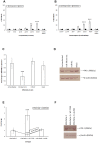TP53/miR-34a-associated signaling targets SERPINE1 expression in human pancreatic cancer
- PMID: 31986125
- PMCID: PMC7041729
- DOI: 10.18632/aging.102776
TP53/miR-34a-associated signaling targets SERPINE1 expression in human pancreatic cancer
Abstract
Pancreatic ductal adenocarcinoma (PDAC) is a disease of aging. The TP53 gene product regulates cell growth, aging, and cancer. To determine the important targets of TP53 in PDAC, we examined the expression of 440 proteins on a reverse phase protein array (RPPA) in PDAC-derived MIA-PaCa-2 cells which either had WT-TP53 or lacked WT-TP53. MIA-PaCa-2 cells have a TP53 mutation as well as mutant KRAS and represent a good in vitro model to study PDAC. RPPA analysis demonstrated expression of tumor promoting proteins in cells that lacked WT-TP53; and this feature could be reversed significantly when the cells were transfected with vector encoding WT-TP53 or treated with berberine or a modified berberine (BBR). Expression of miR-34a-associated signaling was elevated in cells expressing WT-TP53 compared to cells expressing mTP53. Results from in vivo studies using human PDAC specimens confirmed the in vitro results as the expression of miR-34a and associated signaling was significantly decreased in PDAC specimens compared to non-cancerous tissues. This study determined SERPINE1 as a miR-34a target with relevance to the biology of PDAC. Thus, we have identified a key target (SERPINE1) of the TP53/miR-34a axis that may serve as a potential biomarker for early detection of pancreatic cancer.
Keywords: Aging; PDAC; SERPINE1; TP53; cancer; miR-34a.
Conflict of interest statement
Figures






References
Publication types
MeSH terms
Substances
Grants and funding
LinkOut - more resources
Full Text Sources
Medical
Research Materials
Miscellaneous

